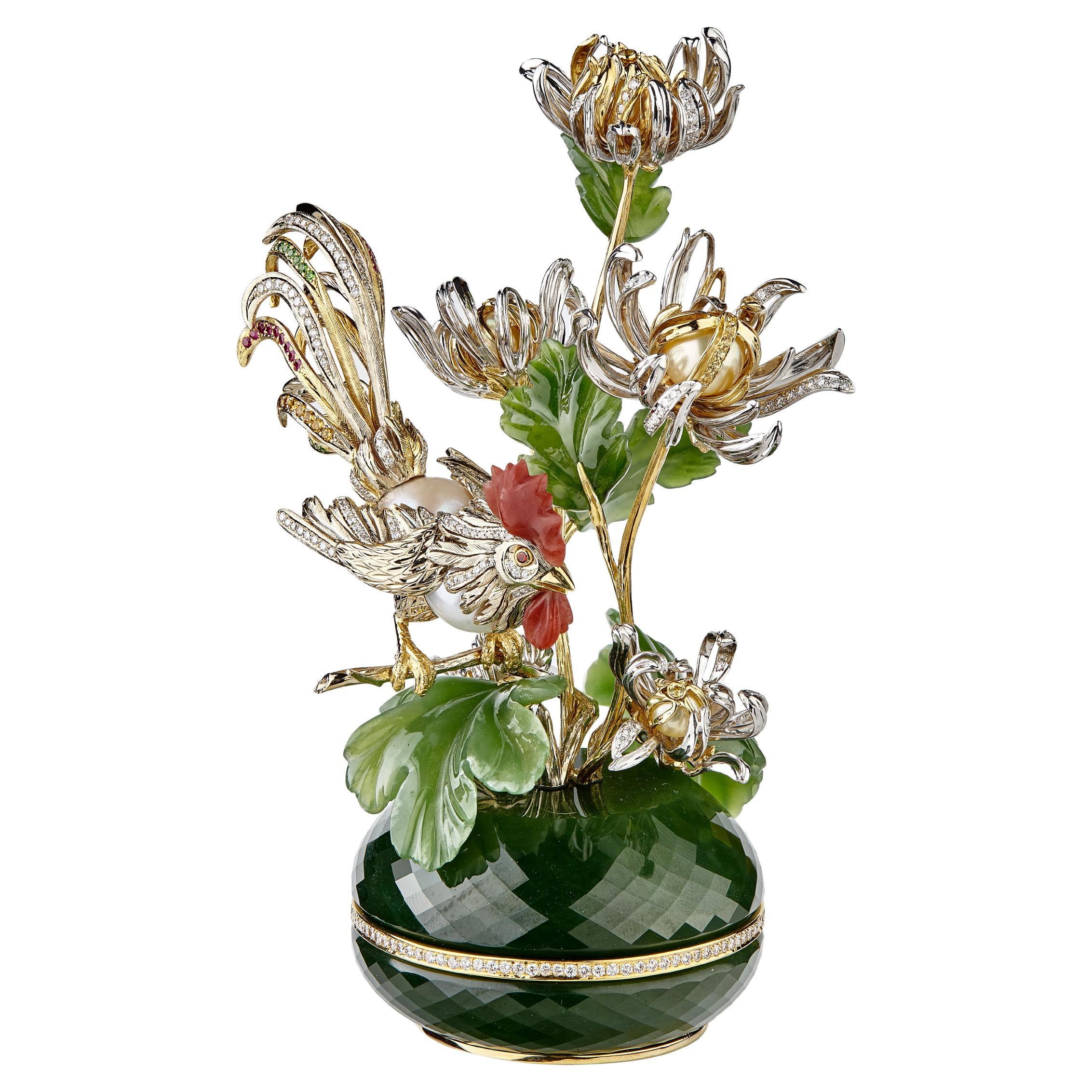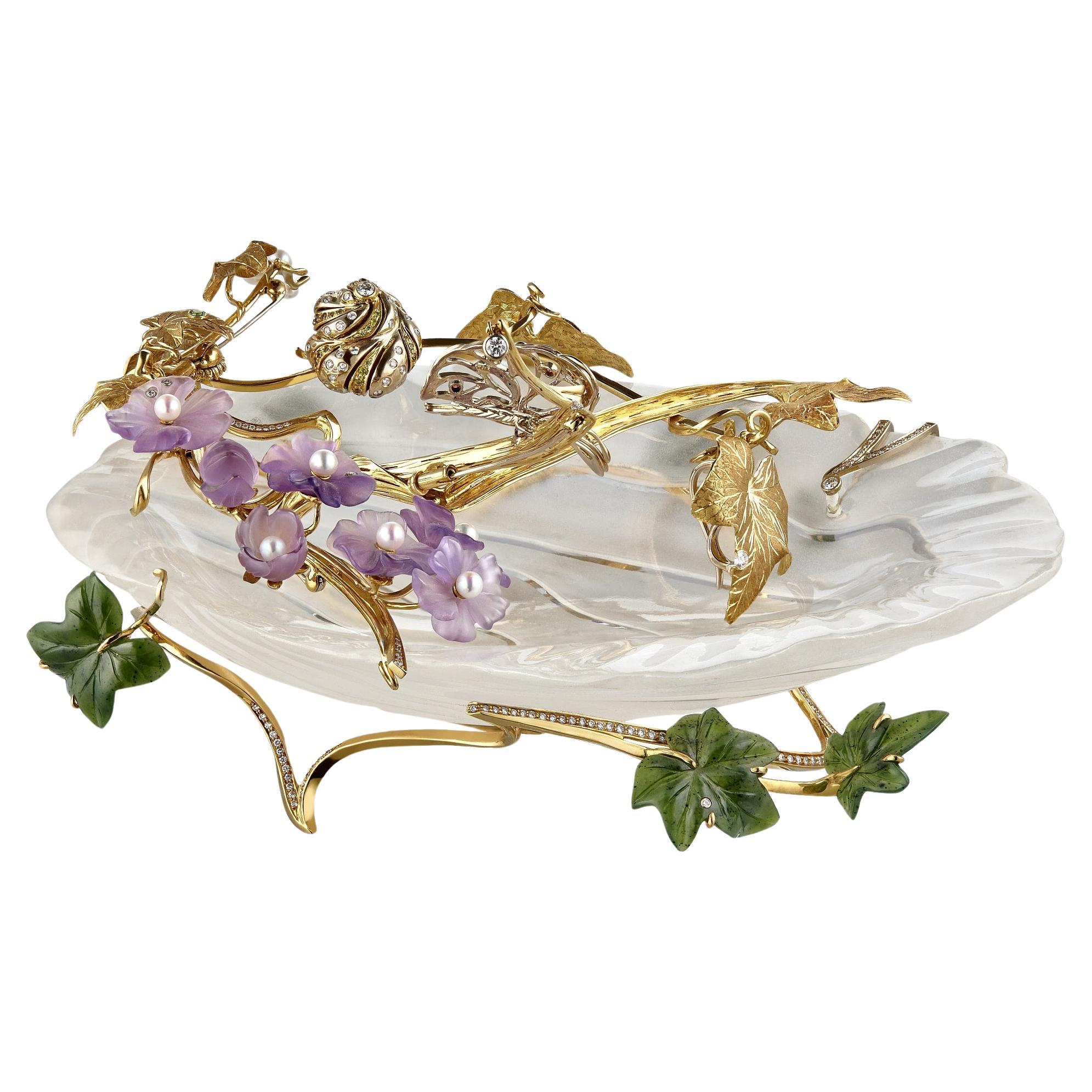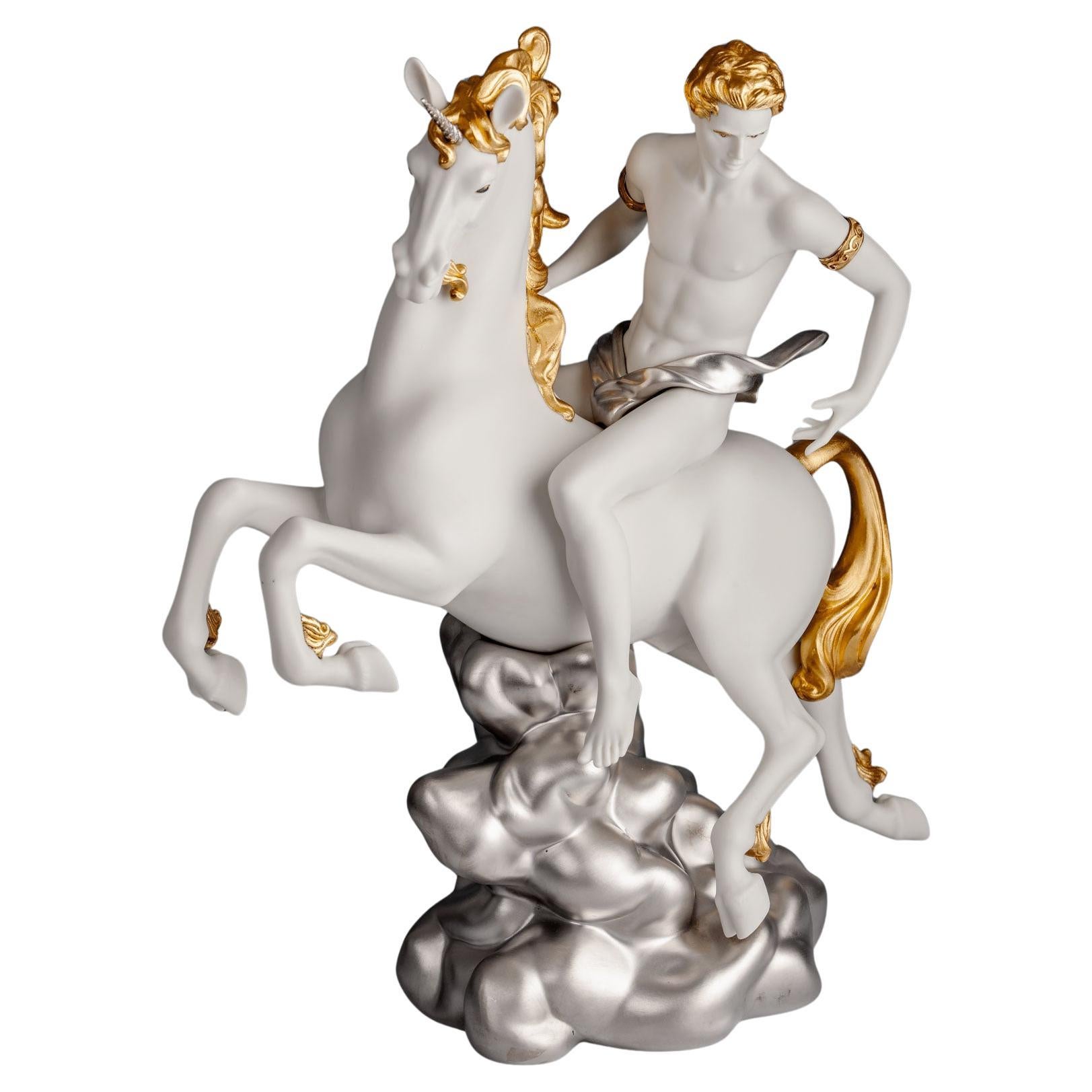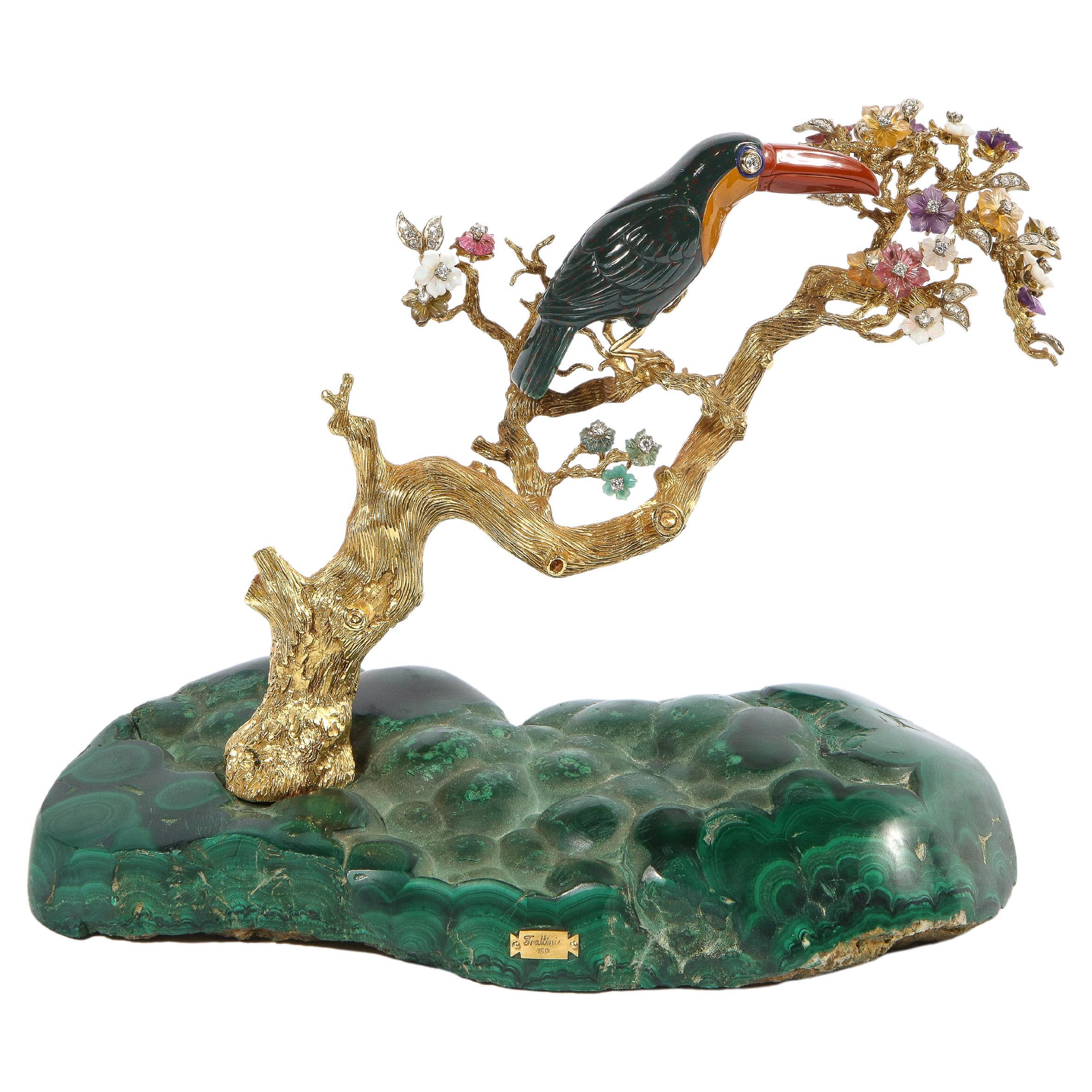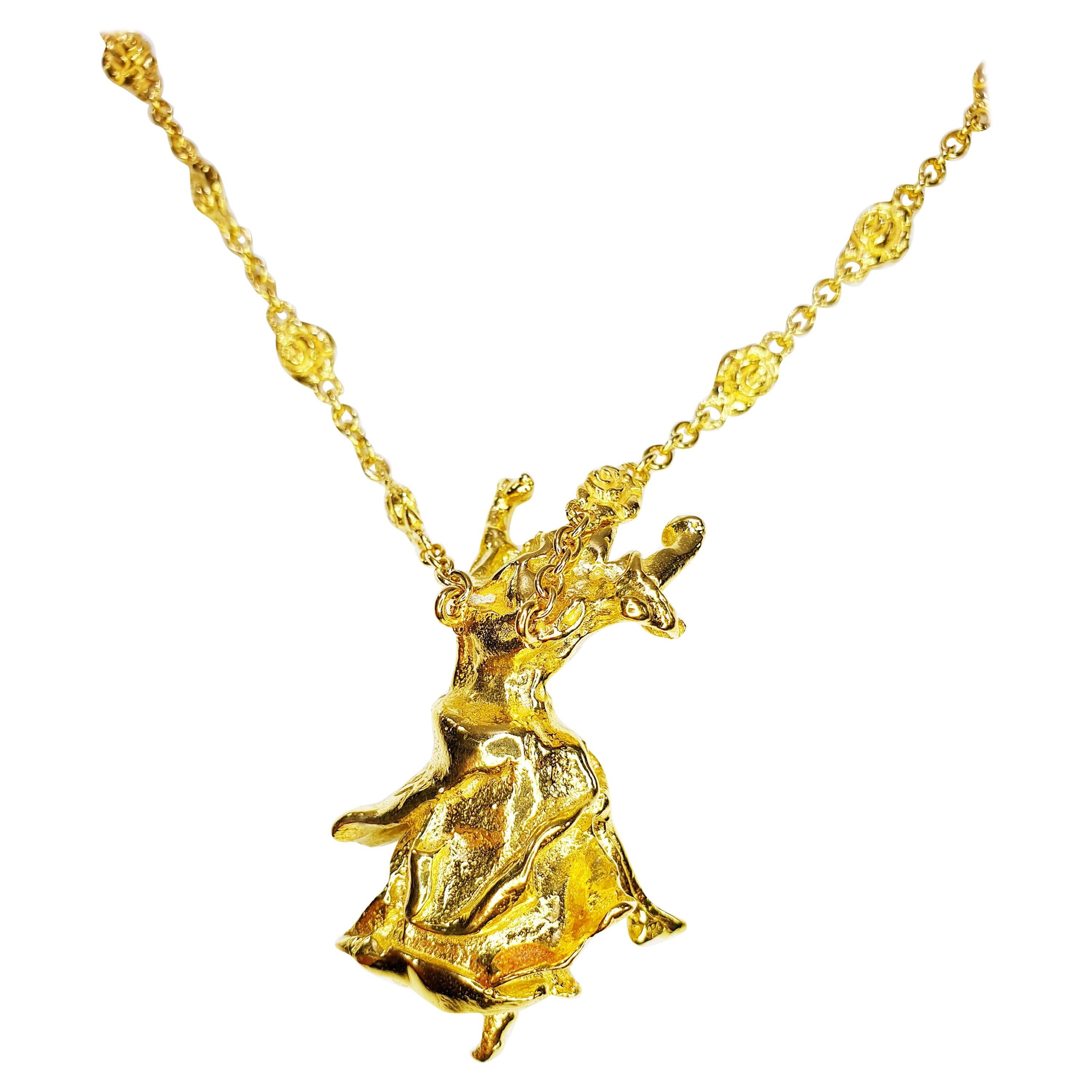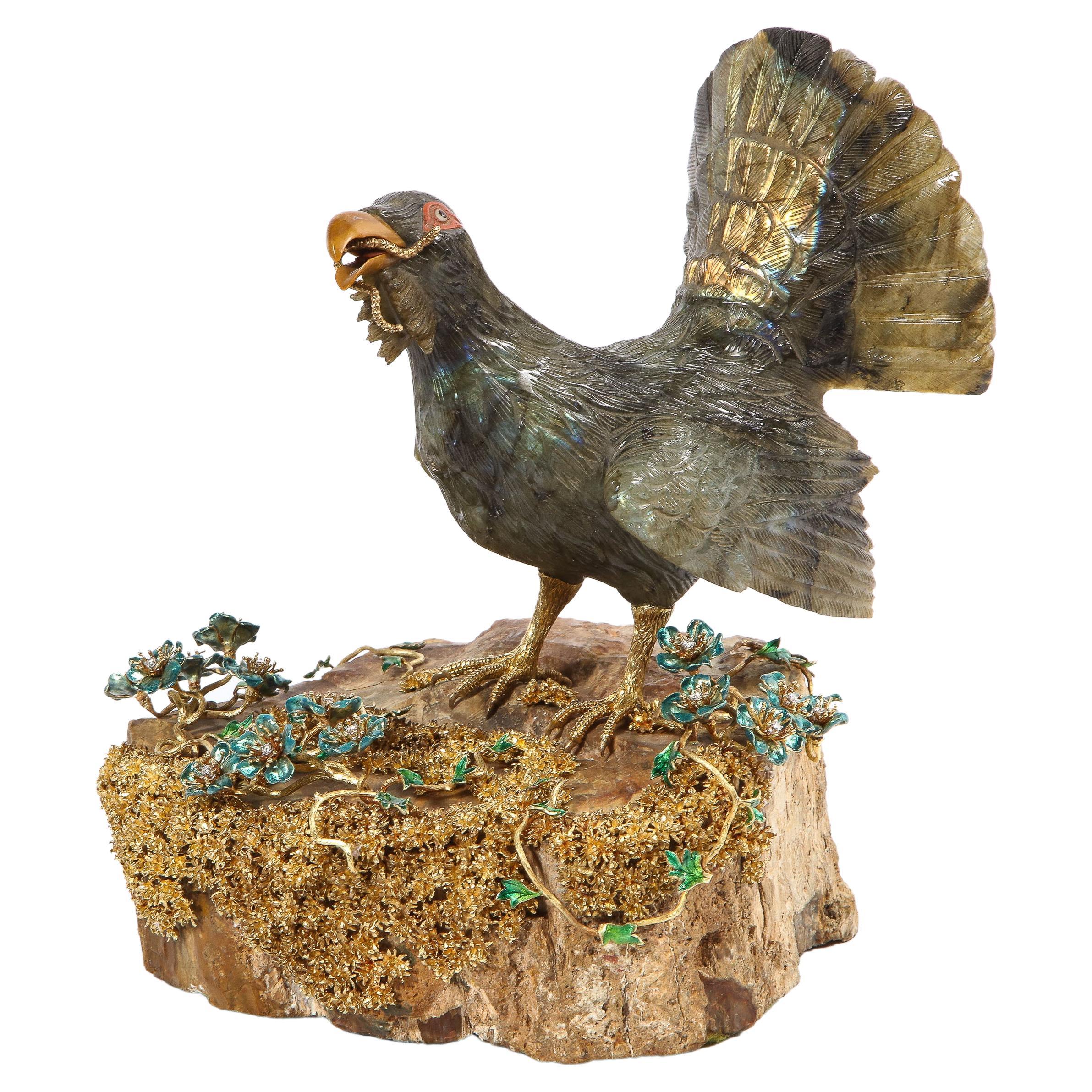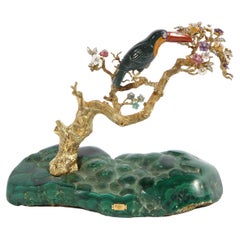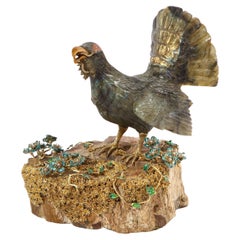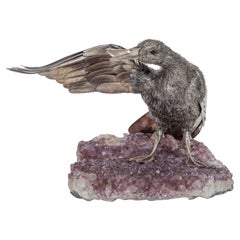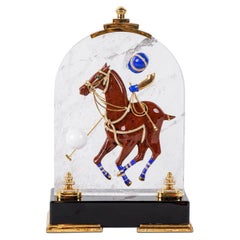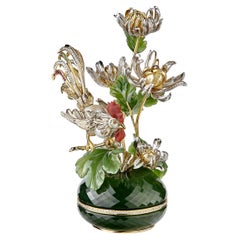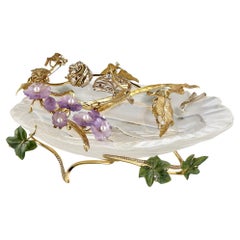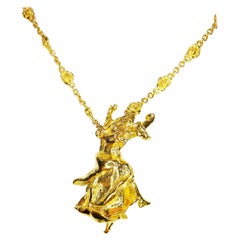Items Similar to An 18K Gold and Gem Set Bust of a King, by George Weil London
Want more images or videos?
Request additional images or videos from the seller
1 of 16
An 18K Gold and Gem Set Bust of a King, by George Weil London
About the Item
An 18K Gold and Gem Set Bust of a King, by George Weil London, circa 1970
This magnificent 18K gold and gem-set bust of a king, crafted by George Weil in London, stands as an embodiment of artistic and royal magnificence, destined to captivate the discerning collector with its opulence.
Weil's masterful touch is evident in every detail of the stylized face and beard of the king, revealing a harmonious blend of skill and creativity. The crown, adorned with diamonds, emeralds, sapphires, and pearls, crowns the figure with a resplendent aura, evoking a sense of majesty and authority that befits royalty.
The bust is poised on a lapis lazuli plinth, adding depth and richness to the composition. Lapis lazuli, historically associated with royalty and power, further accentuates the regal theme of the sculpture.
Aesthetically framed within a plexiglass box, this royal bust takes center stage, preserved and protected for generations to come. The presentation on a black painted wood base enhances the overall visual impact, providing a fitting stage for the king's grandeur to unfold.
Owning this masterpiece by George Weil is more than acquiring a sculpture; it is an investment in a narrative of royal elegance. The interplay of gold and precious gemstones, coupled with Weil's artistic vision, elevates this piece to a pinnacle of luxury and sophistication.
Plexiglass box: 13" high x 6" wide
Bust and plinth: 9.5" high
Very good condition. Ready to place.
- Creator:
- Metal:
- Stone:
- Stone Cut:
- Dimensions:Height: 13 in (330.2 mm)Width: 6 in (152.4 mm)Length: 6 in (152.4 mm)
- Place of Origin:
- Period:
- Date of Manufacture:C. 1970
- Condition:
- Seller Location:New York, NY
- Reference Number:1stDibs: LU1494221008112
About the Seller
No Reviews Yet
Vetted Professional Seller
Every seller passes strict standards for authenticity and reliability
Established in 1980
1stDibs seller since 2019
7 sales on 1stDibs
Typical response time: 1 hour
- ShippingRetrieving quote...Shipping from: New York, NY
- Return Policy
Authenticity Guarantee
In the unlikely event there’s an issue with an item’s authenticity, contact us within 1 year for a full refund. DetailsMoney-Back Guarantee
If your item is not as described, is damaged in transit, or does not arrive, contact us within 7 days for a full refund. Details24-Hour Cancellation
You have a 24-hour grace period in which to reconsider your purchase, with no questions asked.Vetted Professional Sellers
Our world-class sellers must adhere to strict standards for service and quality, maintaining the integrity of our listings.Price-Match Guarantee
If you find that a seller listed the same item for a lower price elsewhere, we’ll match it.Trusted Global Delivery
Our best-in-class carrier network provides specialized shipping options worldwide, including custom delivery.More From This Seller
View All18K Gold, Diamonds, Amethyst, Tourmaline, Bloodstone, and Jasper Toucan Bird
By Gianfranco Frattini
Located in New York, NY
An 18K gold, diamonds, amethyst, tourmaline, bloodstone, carved emerald, opal and jasper toucan bird resting on a gold tree branch, mounted on a carved malachite base.
A very rare and unique gold-mounted jeweled object...
Category
20th Century Italian Figurines and Sculptures
Materials
Amethyst, Diamond, Tourmaline, Jasper, 18k Gold
Rare 18K Gold, Enamel and Diamond Mounted Carved Labradorite Turkey Bird
Located in New York, NY
A rare 18K gold, enamel and diamond mounted carved labradorite turkey bird sculpture on a petrified wood base, attributed to Manfred Wild, Idar-Oberstein, ...
Category
20th Century German Figurines and Sculptures
Materials
Diamond, Labradorite, 18k Gold, Enamel
An Elegant Mario Buccellati Sterling Silver Duck Perched on an Amethyst Base
By Mario Buccellati
Located in New York, NY
An Elegant Mario Buccellati Sterling Silver Duck Perched on an Amethyst Base, Milan, 20th Century
This exquisite creation epitomizes the craftsmanship and luxury for which Mario Buc...
Category
20th Century Italian Figurines and Sculptures
Materials
Amethyst, Sterling Silver
Mellerio Paris, French Gold, Diamonds, Silver, Lapis, and Obsidian Polo Player
By Mellerio dits Meller
Located in New York, NY
Mellerio Paris, A French Gold, Diamonds, Silver-Gilt, Rock Crystal, Enamel, Emerald, Lapis Lazuli, Agate, Emerald, and Obsidian Polo Player, Carved Horse Sculpture, Jeweled Mounted Object.
An extremely rare and unique, one of a kind French Carved Horse Sculpture, Jeweled Mounted Object sculpture "CHEVAUX DE LEGENDE", "A Legendary Horse" by Mellerio, Paris, circa 1999.
Sitting on black obsidian base, the solid rock-crystal slab is finely applied with a carved obdisian hardstone horse and polo player, mounted in 18k gold, brilliant -cut diamonds, emaralds, enamel, lapis lazuli, and agate, .The obsidian base with a plaque engraved: CHEVAUX DE LEGENDE" / MELLERIO DITS MELLER PARIS / 5003 DIV
The piece is in excellent condition and comes with a custom made wood case made for transport. It's very elegant and has French hallmarks throughout. A truly magnificent piece.
Measures 12" high x 8" wide x 4" deep
Founded in France in 1613 by the descendants of Italian immigrants from the Vigezzo Valley in the north of Italy, Mellerio is one of the oldest jewellery houses in Europe. The family business soon attracted the attention of the Royal Court and Marie Antoinette herself reportedly purchased a precious bracelet featuring 7 cameos surrounded by rubies in 1780. Later on, in the 19th century, Mellerio became the official supplier of the French Royal family and the Court of Netherland.
Mellerio creates many jewellery items, all set with rare gems such as peridots, amethysts, aquamarines, citrines and topaz, applying for a patent, the flexible stem, a very supple and light jewellery mechanism. Mellerio remains also well known for their spectacular series of Art Nouveau jewels, created at the beginning of the 20th century, as well as for the creation of trophies rewarding some of the greatest footfall and tennis players of history. In 1993, the jewellery house launched their first watch collection.
Today, Mellerio has stores in Paris, Japan and Hong Kong.
July 14, 1789: this date is known throughout the world as the beginning of the French Revolution. According to a ledger belonging to House of Mellerio, this was also the day that the jeweler sold a golden key to the Comte de Coutance for 10 livres. This ledger, as well as inventories dating as far back as 1768, are the jeweler’s oldest archives. These archives have continued to grow over the years, as the House, established on rue de la Paix in Paris, still lives on today, still in the hands of the same family from Craveggia, in the North of Italy.
The tumultuous history of the Mellerio family in France probably goes as far back as the Italian wars of the Renaissance, but the first official document proving their commercial activity in Paris dates back to 1613. This document is the famous royal warrant awarded by Marie de Medici to a number of Italian families established along the rue des Lombards, including the Mellerios, allowing them to sell “small jewelery items”, therefore granting them a small exception to the traditional monopoly enjoyed by Parisian jewelers. At that time, powerful corporations regulated the operations and customs of Parisian business, but thanks to this exceptional warrant, the Mellerios managed to escape the confines of this framework. Today, this wax-sealed document is kept at the city hall of Craveggia.
From 1613 to the Revolution, the Mellerios lived between France and Italy. The corporations tried many times to put an end to their trade privileges, but all in vain, as a dynasty of sovereigns renewed the warrant. Always marrying and often retiring in Craveggia, the Mellerios continued to maintain their jewelry business in Paris. At first, they did this without a shop. Wearing backpacks (wooden boxes divided into small compartments where jewels were kept), they would tour town fairs around Paris and royal castles.
This is how Jean-Baptiste Mellerio (1765-1850) is said to have sold a bracelet set with rubies and Antique cameos to Marie-Antoinette, which still exists today. Many elements seem to prove the veracity of this anecdote. The queen was particularly fond of cameos, which cover the entire background of her famous jewelry cabinet, and ruby was her favorite stone after diamond. The famous bracelet, reacquired a few years ago by the House of Mellerio, is indeed an 18th century jewel, set with antique cameos representing the profiles of Roman emperors. Two branches of the family were operating in Paris during this time, under the reign of Louis XVI: that of Jean-François (1746-1828), the paternal ancestor of the current Mellerios, and that of Jean-Baptiste (1765-1850).
The French Revolution forced them to return to Italy. However, both Jean-Baptiste and François Mellerio (1772-1843), who was the son of Jean-François, were eventually able to return to Paris after the founding of the Consulate. Jean-Baptiste opened a shop at the Iron Crown of rue Vivienne, and François opened his at the Palais des Tuileries, rue du Coq Saint-Honoré. His well-organized order books give an idea of his high-ranking clientele during the “Old Regime”, among which were the Comte and Comtesse Octave de Segur, the Marquise (later Duchess) de Tourzel, former governess of the royal children, and her daughter, the Comtesse de Bearn, the Craufurds -who organized the flight to Varennes, the Duc and Duchess de Gramont, the Comtesse de Boigne, and Madame de Souza, Talleyrand’s mistress.
We also see the names of the imperial family: Empress Josephine, the Queen of Holland, Princess Elisa, Caroline and Pauline. At that time, the House of Mellerio specialized, among other things, in the trade of antique cameos, a newly fashionable genre of jewel that captured the imagination of all the princesses and noble women of the time.
The years of the Restauration and July Monarchy were among the most glorious. The Bourbons were back on the throne, and the clientele of the House of Mellerio had regained its former wealth. Mellerio supplied Louis-Philippe, Duke of Orléans, as well as his mother, wife and sister, with sumptuous jewels, including a set of emeralds made piece by piece, while the Duke of Bourbon, last prince of the House of Condé, offered diamonds to his mistress, the scheming Baronne de Feucheres, and Monsieur de LaFayette also bought cameos for one of his granddaughters. For the first time, Mellerio ventured into the world of arts in 1815, when Carlotta Grisi, a famous dancer who created Giselle, as well as an actress named Rachel, bought jewels at the Mellerio store on rue de la Paix.
1848 marked a new turning point. France once again became a Republic. François Mellerio handed the company over to his son, Jean, and the latter decided to travel to Spain to build a new clientele. He later became one of the jewelers of the royal family, and met Eugénie de Montijo, who remained a faithful client when she became empress of the French people. The Imperial years were lavish. During the Second Empire, Paris was a pageant of crinoline dresses designed by Worth, while jewels by Mellerio, Worth’s neighbour on the rue de la Paix, adorned the noble women of the Tuileries court.
The Empress bought pearls. Mathilde Bonaparte...
Category
20th Century French Art Deco Figurines and Sculptures
Materials
Agate, Diamond, Emerald, Rock Crystal, Gold, Silver
Exquisite 14K Gold, Diamonds, Emeralds, Rubies, Semi Precious Stone Camel
Located in New York, NY
An Exquisite 14K Gold, Diamonds, Emeralds, Rubies, Sapphires, and Semi Precious Stone Mounted Rhodonite Camel.
Circa 1970, Italy
A very good quality and unusual gold mounted jeweled object...
Category
20th Century Italian Figurines and Sculptures
Materials
Coral, Diamond, Emerald, Moonstone, Pearl, Ruby, Blue Sapphire, 14k Gold
Mellerio Paris, a French Gold, Diamonds, Silver, and Smoky Quartz Carved Horse
By Mellerio dits Meller
Located in New York, NY
Mellerio Paris, A French Gold, Diamonds, Silver-Gilt, Rock-Crystal, Jade, Mother-Of-Pearl and Smoky Quartz, Carved Horse Sculpture, Jeweled Mounted Object.
An extremely rare and unique, one of a kind French gold, diamonds, Silver-gilt, rock-crystal, jade, obsidian, mother-of-pearl, and smoky quartz carved jeweled sculpture "CHEVAUX DE LEGENDE", "A Legendary Horse" by Mellerio, Paris, circa 1991.
Sitting on black obsidian base, the solid rock-crystal slab is finely applied with a carved smoky -quartz and jade horse with a harness mounted in 18k gold, brilliant -cut diamonds, rubies, turquoise, and amethyst chains and pendants. The top columns adorned with 18k gold and brilliant cut diamond pendants, the bottom with gold and mother of pearl plaques. The obsidian base with a plaque engraved: CHEVAUX DE LEGENDE" / N° 05 / MELLERIO DITS MELLER / PARIS / 5003 D
The piece is in excellent condition and comes with a custom made wood case made for transport. It's very elegant and has French hallmarks throughout. A truly magnificent piece.
Measures 10.5" high x 8.5" wide x 4" deep
Founded in France in 1613 by the descendants of Italian immigrants from the Vigezzo Valley in the north of Italy, Mellerio is one of the oldest jewellery houses in Europe. The family business soon attracted the attention of the Royal Court and Marie Antoinette herself reportedly purchased a precious bracelet featuring 7 cameos surrounded by rubies in 1780. Later on, in the 19th century, Mellerio became the official supplier of the French Royal family and the Court of Netherland.
Mellerio creates many jewellery items, all set with rare gems such as peridots, amethysts, aquamarines, citrines and topaz, applying for a patent, the flexible stem, a very supple and light jewellery mechanism. Mellerio remains also well known for their spectacular series of Art Nouveau jewels, created at the beginning of the 20th century, as well as for the creation of trophies rewarding some of the greatest footfall and tennis players of history. In 1993, the jewellery house launched their first watch collection.
Today, Mellerio has stores in Paris, Japan and Hong Kong.
July 14, 1789: this date is known throughout the world as the beginning of the French Revolution. According to a ledger belonging to House of Mellerio, this was also the day that the jeweler sold a golden key to the Comte de Coutance for 10 livres. This ledger, as well as inventories dating as far back as 1768, are the jeweler’s oldest archives. These archives have continued to grow over the years, as the House, established on rue de la Paix in Paris, still lives on today, still in the hands of the same family from Craveggia, in the North of Italy.
The tumultuous history of the Mellerio family in France probably goes as far back as the Italian wars of the Renaissance, but the first official document proving their commercial activity in Paris dates back to 1613. This document is the famous royal warrant awarded by Marie de Medici to a number of Italian families established along the rue des Lombards, including the Mellerios, allowing them to sell “small jewelery items”, therefore granting them a small exception to the traditional monopoly enjoyed by Parisian jewelers. At that time, powerful corporations regulated the operations and customs of Parisian business, but thanks to this exceptional warrant, the Mellerios managed to escape the confines of this framework. Today, this wax-sealed document is kept at the city hall of Craveggia.
From 1613 to the Revolution, the Mellerios lived between France and Italy. The corporations tried many times to put an end to their trade privileges, but all in vain, as a dynasty of sovereigns renewed the warrant. Always marrying and often retiring in Craveggia, the Mellerios continued to maintain their jewelry business in Paris. At first, they did this without a shop. Wearing backpacks (wooden boxes divided into small compartments where jewels were kept), they would tour town fairs around Paris and royal castles.
This is how Jean-Baptiste Mellerio (1765-1850) is said to have sold a bracelet set with rubies and Antique cameos to Marie-Antoinette, which still exists today. Many elements seem to prove the veracity of this anecdote. The queen was particularly fond of cameos, which cover the entire background of her famous jewelry cabinet, and ruby was her favorite stone after diamond. The famous bracelet, reacquired a few years ago by the House of Mellerio, is indeed an 18th century jewel, set with antique cameos representing the profiles of Roman emperors. Two branches of the family were operating in Paris during this time, under the reign of Louis XVI: that of Jean-François (1746-1828), the paternal ancestor of the current Mellerios, and that of Jean-Baptiste (1765-1850).
The French Revolution forced them to return to Italy. However, both Jean-Baptiste and François Mellerio (1772-1843), who was the son of Jean-François, were eventually able to return to Paris after the founding of the Consulate. Jean-Baptiste opened a shop at the Iron Crown of rue Vivienne, and François opened his at the Palais des Tuileries, rue du Coq Saint-Honoré. His well-organized order books give an idea of his high-ranking clientele during the “Old Regime”, among which were the Comte and Comtesse Octave de Segur, the Marquise (later Duchess) de Tourzel, former governess of the royal children, and her daughter, the Comtesse de Bearn, the Craufurds -who organized the flight to Varennes, the Duc and Duchess de Gramont, the Comtesse de Boigne, and Madame de Souza, Talleyrand’s mistress.
We also see the names of the imperial family: Empress Josephine, the Queen of Holland, Princess Elisa, Caroline and Pauline. At that time, the House of Mellerio specialized, among other things, in the trade of antique cameos, a newly fashionable genre of jewel that captured the imagination of all the princesses and noble women of the time.
The years of the Restauration and July Monarchy were among the most glorious. The Bourbons were back on the throne, and the clientele of the House of Mellerio had regained its former wealth. Mellerio supplied Louis-Philippe, Duke of Orléans, as well as his mother, wife and sister, with sumptuous jewels, including a set of emeralds made piece by piece, while the Duke of Bourbon, last prince of the House of Condé, offered diamonds to his mistress, the scheming Baronne de Feucheres, and Monsieur de LaFayette also bought cameos for one of his granddaughters. For the first time, Mellerio ventured into the world of arts in 1815, when Carlotta Grisi, a famous dancer who created Giselle, as well as an actress named Rachel, bought jewels at the Mellerio store on rue de la Paix.
1848 marked a new turning point. France once again became a Republic. François Mellerio handed the company over to his son, Jean, and the latter decided to travel to Spain to build a new clientele. He later became one of the jewelers of the royal family, and met Eugénie de Montijo, who remained a faithful client when she became empress of the French people. The Imperial years were lavish. During the Second Empire, Paris was a pageant of crinoline dresses designed by Worth, while jewels by Mellerio, Worth’s neighbour on the rue de la Paix, adorned the noble women of the Tuileries court.
The Empress bought pearls. Mathilde Bonaparte...
Category
20th Century French Figurines and Sculptures
Materials
Amethyst, Diamond, Jade, Quartz, Rock Crystal, Ruby, Turquoise, Gold, Si...
You May Also Like
MOISEIKIN 18K Gold Diamond and Pearl Floral Miniature
By MOISEIKIN
Located in Hong Kong, HK
An exquisite floral miniature with chrysanthemums and a golden rooster was created inspired by the Eastern Asian Painting "Flowers and Birds."
Chrysan...
Category
2010s Russian Arts and Crafts Figurines and Sculptures
Materials
Blue Sapphire, Ruby, Pearl, Jade, Garnet, Diamond, Chalcedony, 18k Gold
18K Gold transforming jewellery Interior Object by Viktor Moiseikin
Located in Hong Kong, HK
All in this world is a reflection
Of divine love and eternal art.
And we're seeking inspiration,
In the feelings – strings of soul harps.
-Viktor Moiseikin -
The 'Serenity' interior decoration by MOISEIKIN is a beautiful combination of modern and traditional jewellery art. The large carved quartz jewel plate, in which you can place your jewellery, represents the water where the natural lives concentrate. Delicately carved Clematis leaves made of jade and gold gently as if embracing precious pure water. The golden fluttering butterfly and snail are embedded with precious gems that bring charm. One beautiful and shining moment of nature is precisely and artistically reflected in this gold and jewellery artwork...
Category
2010s Thai Artisan Figurines and Sculptures
Materials
Cultured Pearl, Sapphire, Quartz, Jade, Garnet, Diamond, Amethyst, Yello...
Price Upon Request
Legend Collection by Lladró "Divine Love" Porcelain No. 8 w/ 18K Gold & Diamonds
By Vicente Gracia Art Jewellery
Located in Valencia, ES
Legend Collection by Lladró "Divine Love" Porcelain No. 8 w/ 18K Gold & Diamonds
Amor Divino: A Masterpiece of Love and Purity
Step into a realm of divine artistry with Amor Divino...
Category
Early 2000s Spanish Renaissance Figurines and Sculptures
Materials
Diamond, Blue Sapphire, Gold, 18k Gold, 24k Gold, White Gold, Silver
Solid 18k Gold Salvador Dalí Carmen of Crótalos Necklace Sculpture
By Salvador Dalí
Located in Bilbao, ES
The Carmen La Crotalos necklace was designed to celebrate the Metropolitan Opera House performance of Carmen. This crossover between painting and jewellery was something explored in ...
Category
Vintage 1970s Spanish Artisan Figurines and Sculptures
Materials
Gold, 18k Gold, Yellow Gold
18k Gold Naked Woman climbing a staircase by Salvador Dalí Sculpture Necklace
By Salvador Dalí
Located in Bilbao, ES
Naked Woman Climbing a Staircase (originally in French Femme nue montant l'escalier) is a drawing done with pencil and charcoal on card made by Joan Miró in 1937
According to the Joa...
Category
Vintage 1970s Spanish Artisan Figurines and Sculptures
Materials
Gold, 18k Gold, Yellow Gold
"Madonna de Port Lligat" Pendentif Necklace Solid 18k Gold by Salvador Dalí
By Salvador Dalí
Located in Bilbao, ES
Unique 18k Yellow Gold Salvador Dali Madonna de Port Lligat Pendant Necklace / Bracelet
This is a limited edition numbered piece from 1970's, number 0040/ out of 1000
This necklace comes with a pouch and a frame for collectors piece exhibit
Accompanying card from Exmundart Original rights from Land Spring Enginering Ltd, propietor of the exclusive world-wide rights on this sculpture-jewel as stated in the document ordained by Salvador Dalí, and legalised by Mr. José Gómez de la Serna, Notary of Barcelona Spain.
Details:
Sculpture-Jewel cast wit the use of the lost wax process and denominated
Madonna de Port Lligat
Length:
Bracelet 8¨"/ 20cm
Necklace alone 17,32" / 44cm
Necklace with bracelet...
Category
Vintage 1970s Spanish Artisan Figurines and Sculptures
Materials
Gold, 18k Gold, Yellow Gold
Recently Viewed
View AllMore Ways To Browse
Blue King
George Bust
Black Diamond London Blue
Royal Blue Lapis
Vintage Royal Crown Figurines
George Weil Gold
Doris Lindner
Faberge Tortoise
Japanese Momoiro
Lemire Cupid Bronze
Royal Worcester Horses
Silver Italian Spinone
Sterling Silver Horse Figurines
Tiffany Silver Circus Animals
3 Stone Citrine Ring
6 Jewels Swiss Watch
Art Deco Pink Sapphire Ring
Black Leather Watch Yellow Gold
